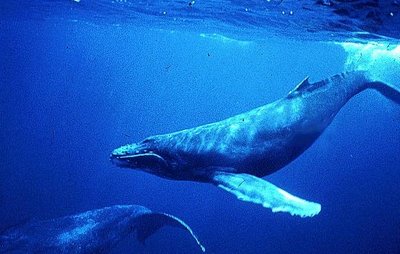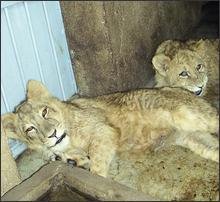 ...The study's authors, from the department of neuroscience at Mount Sinai School of Medicine in New York, say that spindle neurons probably first appeared in the common ancestor of humans about 15 million years ago and that they are found in great apes and humans but not in lesser apes and other primates...
...The study's authors, from the department of neuroscience at Mount Sinai School of Medicine in New York, say that spindle neurons probably first appeared in the common ancestor of humans about 15 million years ago and that they are found in great apes and humans but not in lesser apes and other primates... 
 Two rare Ethiopian lion cub's rest inside their enclosure at the Lion Zoo in the Ethiopian capital, Addis Ababa, Wednesday, Nov. 22, 2006. The zoo is poisoning rare lion cubs and selling the corpses to be stuffed because it doesn't have enough money to care for the animals, which are the national symbol, the zoo's administrator said Wednesday. "These animals are the pride of our country," Muhedin Abdulaziz of the Lion Zoo told The Associated Press. "But our only alternative right now is to send them to the taxidermist." Ethiopia's lions, famous for their black manes, adorn statues and the local currency. Wildlife experts estimate that only 1,000 Ethiopian lions, which are smaller than other lions, remain in the wild. (AP Photo/Les Neuhaus)
Two rare Ethiopian lion cub's rest inside their enclosure at the Lion Zoo in the Ethiopian capital, Addis Ababa, Wednesday, Nov. 22, 2006. The zoo is poisoning rare lion cubs and selling the corpses to be stuffed because it doesn't have enough money to care for the animals, which are the national symbol, the zoo's administrator said Wednesday. "These animals are the pride of our country," Muhedin Abdulaziz of the Lion Zoo told The Associated Press. "But our only alternative right now is to send them to the taxidermist." Ethiopia's lions, famous for their black manes, adorn statues and the local currency. Wildlife experts estimate that only 1,000 Ethiopian lions, which are smaller than other lions, remain in the wild. (AP Photo/Les Neuhaus) 
Zoos
A battle for survival
By Danny Rabinowitz
The movie "An Inconvenient Truth," which is currently showing in Israel, has succeeded in surprising and raising the concerns even of veteran environmentalists and earth scientists familiar with the dangers of global warming and have long warned against it. This impressive film, which is based on sound research and features Al Gore, describes the frightening and engrossing reality of the threat to the existence of all of us on earth, in a way that is at once clear and easily accessible. The most worrisome finding that Gore presents is that global warming is not necessarily a slow and defined process, which takes place over hundreds of years. There have already been, and will be more, leaps and bounds in the process. When we were in high school, for example, they taught us that the melting of the ice covering southern Europe as far as Scandinavia took hundreds, perhaps thousands, of years. Up-to-date and detailed research in the fields of climatology, geology and oceanography now indicates that we are talking about something far more dramatic. It is very possible that the retreat of the ice shelf from the Mediterranean Sea to northern Europe took place over the course of 10 or 20 years - a geographic drama of Biblical proportions.
http://www.haaretz.com/hasen/spages/792165.html
Lion Mane Linked To Climate
It's long been known that lions with long, full manes get the girls. Now, an innovative study based on zoo animals all across America shows for the first time that cold temperatures help lions grow their manes long and thick - and more appealing to potential mates.Up to one-half of the length and density of a zoo lion's mane can be attributed to temperature, according to a study that is the cover story of the April issue of the Journal of Mammalogy, published on April 13, 2006. Other factors involved in mane growth include nutrition, social factors, individual history, and genetics."Many variables interact to affect mane development in wild lions," said Dr. Bruce Patterson, MacArthur curator of mammals at The Field Museum i and lead author of the research. Patterson is principal investigator of Earthwatch's Lions of Tsavo project. "Several of these variables, including food, water, and social groupings are controlled in zoological parks, where the authors show climate has a major effect on mane development."
http://www.yubanet.com/cgi-bin/artman/exec/view.cgi/8/34396
Zoo world is watching Rufus, T.K.
Some of the most important genes for the future of the critically endangered orangutan are in Kansas City, just waiting to be introduced.
The Kansas City Zoo now houses the top-rated male and seventh-rated female Bornean orangutans in North America, ranked in terms of their importance for breeding. With the zoo world watching, that is what officials here hope to accomplish.
They have a challenge ahead of them. The last time this female had a baby, she wouldn’t let it nurse and it had to be taken from her. But zookeepers are optimistic that they can condition T.K. — that’s her name — to encourage her maternal instincts.
That will involve desensitizing her to having her breasts touched and pulled so it won’t come as a shock if she produces a baby.
“I worked with T.K. in Omaha, so I know she’s a very smart animal,” said Liz Harmon, general curator at the Kansas City Zoo.
Teaching maternal behavior has worked before with orangutans and gorillas. The main goal is to have babies reared by their mothers, instead of humans, so that maternal instincts can be passed on.
http://www.kansascity.com/mld/kansascity/news/16098394.htm
For elephants, acres to roam
By Julie Stoiber
Inquirer Staff Writer
HOHENWALD, Tenn. - A rumble of thunder sends everyone to the barn windows. Outside, a mighty rain slashes at a stand of stately trees.
Through the gloom, two hulking figures - elephants! - come into focus. They mosey along a rise between the trees and a creek, occasionally raising their heads to the sky.
Curse the storm. It is about to wreck a rare opportunity to watch the world's largest land animals roam, far from their homelands, at a sprawling, sequestered retreat in the rolling hills of middle Tennessee.
Carol Buckley looks at the agitated visitors, then at the tranquil animals, and chuckles.
"To me, this is comical," she said. "This is very inconvenient for what we want to do, but this is heaven for the elephants. Elephants are creatures of nature. They love this kind of weather."
And at the Elephant Sanctuary - which Buckley cofounded 11 years ago as a refuge for zoo and circus retirees, some scarred by years of physical and psychological abuse - if it is good for the animals, it is good. Period.
http://www.philly.com/mld/inquirer/news/local/16096962.htm
National Zoo bans smokingDecision in line with safety efforts across the country
Washington Post
WASHINGTON — Citing safety concerns, officials with the National Zoo have decided to ban smoking at the tourist attraction beginning on Dec. 1.
Smoking already was prohibited in zoo buildings, and keepers weren't allowed to smoke in animal areas. The new policy bans smoking outdoors as well, including on public walkways. Smoking also will be prohibited in zoo golf carts and other vehicles, spokeswoman Peper Long said, and at the Conservation and Research Center in Front Royal, Va.
The policy change was prompted in part by a couple of small fires on zoo grounds during the past year that "were probably connected to smoking," Long said. No one was injured in the fires, which were limited to mulch areas.
Long said she doesn't expect much negative reaction from the 2 million people who visit the zoo each year.
The smoking ban at the National Zoo reflects a trend toward nonsmoking zoos around the country, said Steve Feldman, spokesman for the Association of Zoos and Aquariums.
http://www.chron.com/disp/story.mpl/nation/4358644.html
Zoo offers rare encounter with reindeer11/26/2006 06:42:24
Christmas Eve, children waiting for Santa might hear the jingle of sleighbells on the roof and the faint whisper of reindeer.... burps?
Zoo Keeper Carol Paglucia says reindeer burp a lot. And,children who visit 3-year-old Ealu next weekend will probably get an earful while she snacks on reindeer chow. Families who visit on Dec. 3 will get a unique opportunity to take a picture with Ealu - which might be the last chance this winter to find a reindeer standing still. Meanwhile, the zoo's two reindeer are surviving the warm weather. Zoo Director John Tobias says reindeer help control their body temperature by
using their legs as a natural thermostat. That's just one fact you might learn during the zoo's Reindeer Encounters on Dec. 10, 17 and 24th.
http://www.wjbc.com/wire/05346_Reindeer-WEB_064219.htm
Battle Creek zoo gets expansion gift from brothersBATTLE CREEK, Mich. A 500-thousand-dollar donation from a pair of brothers to the Binder Park Zoo in Battle Creek will fund a new home for two snow leopards and a new amphitheater.
Battle Creek natives Jeff and Doug Smith say the gift was to honor their parents, who have been involved in several community boards and agencies.
The current snow leopard exhibit was built 21 years ago to house Siberian lynx and was modified in 1997 when the snow leopards arrived.
The new exhibit for the 12-year-old male and nine-year-old female snow leopards will be several times larger than the current exhibit when it debuts in 2008. It will feature rock piles, trees and more roaming space to replicate their natural mountain habitat in Central Asia.
http://www.wlns.com/Global/story.asp?S=5729805&nav=0RbQ
Fayette County zoo gets surprise rare specimen
By Bob StilesTRIBUNE-REVIEWMonday, November 27, 2006
As Sonny Herring approached the pasture at his Fayette County zoo, he wondered what the white object was nestled in the grass.
"I thought something else got in the exhibit," Herring said Friday.
It did, but not what Herring was expecting. In the grass was a newborn white buffalo.
"I thought, 'What the heck, we got a white buffalo.' I think the odds are something like one in 10 million," Herring said.
http://www.pittsburghlive.com/x/tribunereview/news/fayette/s_481511.html
Iowa zoo is struggling - as are many others across the Midwest
By Colleen Mastony
Chicago Tribune
(MCT)
DAVENPORT, Iowa - A cold wind whipped through the Fejervary Children's Zoo on a recent day and set the gray wolves howling. Their melancholy chorus echoed through the park.
Nearby, a red fox raced around its pen. Muscular cougars slowly paced in their cage. And a rare white fawn with spindly legs tiptoed inside an enclosure.
Despite the wonders of the century-old zoo, it remains a little-known attraction here.
"I've never heard of it," said Lisa Pedersen, 35, who has lived in the area for eight years and works at the front desk of the city's Radisson hotel. "I didn't know we had a zoo in Davenport."
The city's official visitor map does not include the zoo in its list of local attractions. Even the Yellow Pages neglects to list the Fejervary phone number.
"We are kind of off the beaten path," said Rebecca Spears, the curator at the Fejervary, a little menagerie kept in a series of enclosures in a local park.
The zoo has been a fixture in the city for 101 years. But it might not have many years left. In the wake of several animal deaths this summer - a male bison attacked and killed a fawn, and two other deer died, possibly from drinking stagnant water - the zoo has begun to sell off dozens of animals.
http://www.kansascity.com/mld/kansascity/news/breaking_news/16106065.htm
Zoo can't let toads croak
Call him Dr. Love - at least when it comes to endangered Wyoming toads' love.
Bruce Foster, collections manager of the Central Park Zoo's animal department, is on a mission to breed as many toads as possible to help replenish this once dying species.
But helping the small creatures make a love connection isn't as easy as you would think.
Tucked away behind the zoo's Rain Forest exhibit is a room devoted to Foster's mission.
In an effort to replicate the toads' home turf, Foster and other zoo staff change the room temperature. The water and lighting in each toad tank is also precisely set according to the time of year.
There's even a little "mood music," as one of the zoo staffers calls it. It's actually a recording of other Wyoming toads that Foster plays in the room during mating season.
http://www.nydailynews.com/boroughs/story/474827p-399416c.html
Irwin boy to have zoo birthday party
By Laine Clark
STEVE Irwin's son Bob will publicly celebrate his third birthday at Australia Zoo on Friday, despite concerns about how he is coping with his father's tragic death.
John Stainton, who was the Crocodile Hunter's manager, said today he had no second thoughts about the Australia Zoo promotion on Friday, when Bob's birthday will be celebrated with rides, prizes, cake and free children's entry.
Bob is expected to attend a cake cutting ceremony with his mother Terri and sister Bindi.
The Australia Zoo promotion comes after Terri recently raised concerns about how her children were coping with their father's death, saying she had taken them to see a psychologist.
Mr Irwin died in September when a stingray barb pierced his chest.
"He's a little boy and every little child deserves to have their birthday," Mr Stainton said.
http://www.news.com.au/story/0,23599,20830364-1702,00.html
What a tiger's life is like at Reid Park Zoo
By Jennifer Stoddard
Special to the Arizona Daily Star
Tucson, Arizona Published: 11.27.2006
advertisement
This is the first article in a series the Arizona Daily Star, in cooperation with Reid Park Zoo, will run on the BYOBrain page on the last Monday of each month. It will feature a different zoo animal each month with fun facts about the species and actual animals at the zoo.
Reid Park Zoo has more than 500 animals right here in Tucson. Two of them are the male Indochinese tigers, whose enclosure is located directly to the left of the entrance.
http://www.azstarnet.com/allheadlines/157499
Employees mourn old lion's death at Gwalior Zoo
Gwalior, Nov.27 (ANI): The death of an old lion in Madhya Pradesh's Gwalior Zoo has cast a pall of gloom on the officials as it was the second death here within a week.Most of the employees believe that the 16-year-old lion Raja died due to old age but they are awaiting the post mortem report to ascertain the actual cause of the death.The fact that a four-horned antelope also died three days earlier has aggravated the tension. According to Narendra Sharma, a zoo official, the lion had stopped eating and passed away before the veterinary doctors could attend to him.
http://www.dailyindia.com/show/86342.php/Employees-mourn-old-lions-death-at-Gwalior-Zoo
Zoo’s panda cam hours cut back
By Mark Davis Monday, November 27, 2006, 06:32 PM
The Atlanta Journal-Constitution
Panda lovers, you’re just going to have to grimace and bear the change. Zoo Atlanta’s Panda Cam is no longer 24/7.
The camera that had afforded panda fans an unblinking, unfailing glimpse into the lives of giant panda Lun Lun and her unnamed cub now is operating on banker’s hours — and East Coast hours, at that.
The camera now operates only Monday-Friday, between the hours of 10 a.m.-5 p.m. Eastern Standard Time.
If you’ve been logging on late night or during the weekend to see the baby panda and her mom, forget it. Zoo Atlanta’s Web site won’t have any live images.
Or, if you like peeking at the duo during the work week, but live in Birmingham — that’s in the Central Time Zone, an hour behind Atlanta — you’d better get in the habit of logging on between the hours of 9 a.m.-4 p.m.
If you live in LA, three time zones away? Set the coffee maker for 7 a.m.
http://www.ajc.com/living/content/shared-blogs/ajc/pandas/entries/2006/11/27/zoos_panda_cam_hours_cut_back.html
Purring pandas
Two weeks ago this column ran a story about a zoo in Thailand that was showing what amounted to pornographic movies to its pandas in order to encourage them to breed. At the time, we wondered whether this would work, mainly because nobody is sure if the pandas actually register the big screen images of pandas mating as anything other than moving patterns of light.
As it turns out, it doesn't matter whether or not the pandas can see the porn - what gets them excited is the soundtrack.
Zhang Zhihe, the director of China's Chengdu Research Base of Giant Panda Breeding, said showing movies had led to record high births this year among China's panda population. In the first 10 months of this year, 31 cubs were born in captivity in China, of which 28 survived. That's up from 12 births in 2005 and nine in 2000. Of this year's births, 14 came through natural breeding, while artificial insemination or a combination of the two produced the rest.
The problem has been that pandas are fussy about who they hang out with, and when they grow up in a zoo they have no role models for intimacy. "In the wild they have their own choices when mating," Zhang said. "But when we breed them in captivity it's like taking two human beings and forcing them to mate."
He said the movies had an aphrodisiac effect: "It's the sounds of breeding that stimulate them. Pandas are just like human beings. They understand everything."
http://blogs.smh.com.au/sit/archives/2006/11/purring_pandas.html
Denver Zoo Tries To Save Tiny Endangered Frog
Panamanian Golden Frog Expected To Go Extinct
POSTED: 7:36 pm MST November 27, 2006
DENVER -- The Denver Zoo is part of an effort to save a disappearing frog species that has become Panama's national symbol of nature.
Scientists fear that sometime next year, the last wild Panamanian golden frogs will die. The species is being destroyed by a fungus that is also wiping out other amphibian species. But about two dozen zoos including the Denver Zoo have several hundred of the frogs in captivity.
The fungus was only the final blow for a species whose numbers have long been dwindling because of deforestation, overcollection and water pollution.
So far, the Denver Zoo is one of only three zoos that have been able to coax captive-bred Panamanian golden frogs to reproduce. The zoo is part of Project Golden Frog created to try to save the critically endangered frog.
Rick Haeffner, the zoo's reptiles curator, said one of the biggest problems the program faces is that until the fungus goes away, there's nowhere to release the frogs into the wild.
Native to Central America, the Panamanian frog's bright colors provide a good example of warning coloration. Its skin produces poison when it is attacked, causing pain to its predator.
http://www.thedenverchannel.com/news/10409316/detail.htmlNewborn Cheetahs Doing Well At St. Louis Zoo
. LOUIS (AP) - Four cheetah cubs born ten days ago at the St. Louis Zoo are doing well, zoo officials say today in announcing the births for the first time. The first-time mother, Lucia, is raising the cubs in her maternity den in an area out of view from the public at the River's Edge exhibit of the zoo. Lucia is on loan from a wildlife sanctuary in Florida. The father is Shanto, brought to St. Louis four years ago from a breeding center in The Netherlands. The cubs, two males and two females, weigh about two pounds each and are beginning to open their eyes. The mother and cubs will remain out of public view for several months. The cheetah is endangered throughout Africa. The cheetah population is down to about 12,000.
Seattle zoo open despite snow and cold
THE ASSOCIATED PRESS
SEATTLE -- Schools are closed today in Seattle and some streets are still icy, and snow-covered, but the Woodland Park Zoo is open.
Spokesman Jim Bennett says a few keepers had trouble getting to work but animals are getting food, water and their daily care.
He says many of the animals can handle the temperatures in the 20s. The wolves love it and the bears don't care, although they are a little sleepy this time of year.
The gorillas have heating elements to keep them warm.
And if the elephants and giraffes don't feel like going outside they can stay in their warm barns.
People who want to warm up can check out the tropical rain forest building where it's always warm and moist.
Activists query native animal exports
MELBOURNE and Sydney zoos are pushing ahead with plans to export Australian animals to a controversial Thai wildlife park in exchange for their new elephants.
Chiang Mai Night Safari, the park where the deal obliges the zoos to send the animals, had a high death rate of exhibits, and had to ditch plans to offer some on its restaurant's menu.
A project of deposed prime minister Thaksin Shinawatra, Night Safari was recently reported to have "borrowed" Indonesian orang-utans from wildlife authorities and was under a legal attack for being located inside a national park.
Exports of kangaroos, wallabies, koalas, gliders, possums, dingoes and tawny frogmouth birds from the two Australian zoos are being sought for Night Safari, according to Federal Department of Environment and Heritage documents obtained by animal welfare groups.
http://www.theage.com.au/news/national/activists-query-native-animal-exports/2006/11/28/1164476205183.html
Hippo laughs
Tim White
I swear the hippo laughed at me. A full-bellied roar like a 300-pound pirate on his fourth flagon of rum. It was right after the huge critter showed me his gaping pink maw, studded with stumpy teeth.
It was right out of Kenya, but I was half a world away, at the Forest Park Zoo in Seattle. It was a spur-of-the-moment getaway, a long weekend on the other side of the continent, in a city that does indeed feel half a world away from Fayetteville.
The idea sprouted a few months ago, when Rachel signed up for a veterinary conference there. We’d visited before, and love it. So on a whim, we traded a batch of frequent-flier miles for a pair of tickets and tacked a few vacation days onto the conference for some power-touristing. That included two zoos (Woodland Park in Seattle and the Point Defiance Zoo in Tacoma), the Seattle Aquarium, the Museum of Flight (on the grounds of the Boeing plant; easily one of the best museums I know), plus a botanical garden, shopping in the most eclectic of malls, and gallons of Seattle’s signature drink — excellent coffee.
Although my mind and my camera are filled with images of laughing hippos, playful otters and a majestic jaguar (and the happy discovery that good zoos have transcended the cramped, smelly, inhumane warehouses that they once were), my overriding impression is of the people and the way they have fashioned their city. We can learn something there.
http://www.fayobserver.com/article?id=247841
Panamanian golden frog facing doom
Denver Zoo breeding efforts key in saving plagued amphibian
By Jim Erickson, Rocky Mountain News November 27, 2006
Imagine that all the bald eagles - every last one of them - vanished from the American wilderness overnight.
Something similar is about to happen to Panama's national symbol of nature and wild places: the celebrated Panamanian golden frog.
The brilliant gold-and-black creature, whose image is plastered across everything from T-shirts to lottery tickets in its native land, will soon croak its last croak, biologists say.
Some time next year, the last wild Panamanian golden frogs are expected to die, victims of a lethal skin fungus sweeping southeastward across the Central American isthmus and wiping out entire amphibian communities in its path.
They will become the latest casualties in the staggering, worldwide amphibian decline. The only surviving Panamanian golden frogs will be several hundred captives in about two dozen zoos, including the Denver Zoo.
http://www.rockymountainnews.com/drmn/local/article/0,1299,DRMN_15_5172424,00.html
Exotic pets in U.S. may pose health risk
WASHINGTON — Exotic animals captured in the wild are streaming into the U.S. by the millions with little or no screening for disease, leaving Americans vulnerable to a virulent outbreak that could rival a terrorist act.
Demand for such wildlife is booming as parents try to get their kids the latest pets fancied by Hollywood stars and zoos and research scientists seek to fill their cages.
More than 650 million critters _ from kangaroos and kinkajous to iguanas and tropical fish _ were imported legally into the United States in the past three years, according to U.S. Fish and Wildlife Service documents obtained by The Associated Press under the Freedom of Information Act.
That's more than two for every American.
Countless more pets _ along with animal parts and meats _ are smuggled across the borders as part of a $10 billion-a-year international black market, second only to illegal drugs.
http://www.chron.com/disp/story.mpl/ap/nation/4363614.html
Captive Elephants: Time to let go
SEATTLE POST-INTELLIGENCER EDITORIAL BOARD
Trendy as Seattle is, the city may have a hard time getting its head around an emerging idea at zoos. Some of the nation's biggest zoos are letting their elephants go.
Given the space constraints at Woodland Park Zoo, officials here ought to consider the same approach. Unless elephant habitat expansion beyond the current acre becomes a greater priority here than it seems to be, the zoo will have an increasingly hard time defending its keeping of Earth's largest land animals.
Woodland Park is a leader in many fields of animal care, especially in providing more naturalistic habitat. That includes habitat for elephants, which received a new facility in 1989. The zoo, moreover, has been a real force in the captive breeding of elephants.
http://seattlepi.nwsource.com/opinion/293202_bambooed.html
Zoo seeks help in naming ocelot kitten
Wednesday, November 22, 2006
The Hillsboro Argus
PORTLAND - The debut of the Oregon Zoo's endangered ocelot kitten is happening sooner than expected. The baby boy will make his first public appearance in mid-December instead of January. That's the good news. The bad news is that he's still nameless.
Keepers have chosen their three favorite names and are now seeking the public's help in making the final decision. The three names they have chosen for the online vote are (drum roll, please):
Rio (meaning river or laugh in Spanish or Portuguese).
Mo (short for monkey, because the kitten lives in the zoo's Primate Building, which has been expanded to include species in South America and the Amazon).
Bonito ( meaning beautiful or pretty in Spanish).
To cast your vote for your favorite name, please go to
http://www.oregonzoo.org/Voter/vote_form.cfm.
All votes must be submitted by Monday, Dec. 18.
The ocelot was born Sept. 9 and continues to be nurtured by his mother, Alice. She and her mate, Ralph, came to the zoo on April 22.
http://www.oregonlive.com/news/argus/index.ssf?/base/news/1164227677132720.xml&coll=6Failing to Protect the Psychological Well-Being of Chimpanzees
Congress enacted the AWA in 1966 “to insure that animals intended for use in research facilities or for exhibition purposes or for use as pets are provided humane care and treatment . . . .” 7 U.S.C. § 2131(1). As originally enacted, theAWA left research facilities largely unregulated. See, e.g., 7 U.S.C. § 2143(a) (repealed 1985). In 1985, Congress amended the AWA by enacting the Improved Standards for Laboratory Animals Act, Pub. L. No. 99-198, 99 Stat. 1645. This amendment to the AWA instructed the USDA to “promulgate standards to govern the humane handling, care, treatment, and transportation of animals by dealers, research facilities, and exhibitors.” 7 U.S.C. § 2143(a)(1).
http://www.ca9.uscourts.gov/ca9/newopinions.nsf/977A3690A89BE17D8825722D007DA4DA/$file/0415788.pdf?openelement
Boxing orangutans welcomed home
Forty-eight orangutans who have spent much of their lives performing boxing matches in a Thai zoo have finally been returned to their native Indonesia.
The wife of the Indonesian president was at the airport to welcome the animals, who were confiscated from Bangkok's Safari World two years ago.
They were due back in September, but a Thai military coup thwarted that plan.
They are now heading to a jungle reserve on the island of Borneo, where they will undergo medical tests.
The orangutans, sporting boxing gloves and brightly-coloured shorts, had been a feature at the Safari World park for decades.
But the practice was stopped in 2004 as international pressure mounted, and the animals were confiscated shortly afterwards.
Five other animals belonging to the original troop have remained in Thailand for medical treatment, but are also due to return home.
"We are very happy to get the orangutans back," said the president's wife, Kristiani Yudhoyono. "They belong to our vast nation, therefore we have to take them back to their habitat in a proper way."
Under threat
Experts estimate that there are only 60,000 of the animals left in the wild on Borneo and Sumatra.
Forestry clearance and illegal trading seriously threaten the species, and some estimates suggest those remaining could all but disappear in the course of the next decade.
Forest fires, which some believe are a direct result of clearing the land for oil palm plantations, are also taking their toll.
Earlier this month, animal protection workers said that up to 1,000 orangutans may have died in blazes which have been raging across Borneo for several months.
http://news.bbc.co.uk/2/hi/asia-pacific/6171820.stm
ETHIOPIA'S ABYSSINIAN LIONS STUFFED FOR LACK OF CASHBy AFPMiddle East TimesDwindling finances and shrinking zoo space are reducing already declining population of Ethiopia's famed black-maned Abyssinian lions, the country's national symbol, to mere stuffed mementos. Despite concern among by conservationists, Addis Ababa's historic lion zoo, built nearly 60 years ago, has begun selling lion cubs to taxidermists because it is unable to feed the big cats and lacks room for their increasing numbers. Zoo administrator Muhedin Abdulaziz said that his €50,000 ($64,000) budget was simply not enough to provide for more than 16 adult lions, which cannot be reintroduced to the wild. "There is a shortage of place and a shortage of budget and when they are over-populated, most of the time we send them to taxidermists," Muhedin said, adding that he regretted the practice. "It is not really good, but we do this is because of the problems we have," he said. "But we as experts are telling the government to extend these places to the countryside. That's the best solution." "For the time being our immediate solution is to send them to the taxidermists, but the final and best solution is to extend the zoo into a wider area," Muhedin said. The Abyssinian lions, or panthera leo abyssinica, are smaller than their East African cousins and the males have distinguishable black manes. Experts say that only 1,000 of them remain in the wild in Ethiopia's southern and eastern regions. The culling is done by a vet who kills the cubs with poison. The bodies are sold for about €140 each to taxidermists who then retail the stuffed lions for €335. The zoo, built in 1949 during the reign of Emperor Haile Selassie, was intended to rear the animals for exhibition as symbols of his rule, which ended in 1974 when he was ousted by a pro-Soviet Maxist-Leninist military junta. Currently, there are 15 adult lions and three cubs at the facility, which receives up to 1,200 visitors daily and is also home to monkeys, Egyptian ducks, rabbits, and goldfish. The director of the wildlife division of Ethiopia's agriculture ministry said that he had no idea that the lions were being culled. "We are not aware that this is happening," said Tadese Haile, refusing to comment further on the matter. A wildlife expert said that he was offered 11 cubs last year but declined because he did not have enough land and he felt that the government should inform the public about their plight to attract help. "They have to create public awareness, there should be a lot of people interested in seeing lions," said the expert who spoke condition of anonymity. "In Addis Ababa, there is no proper zoo." "Some experts say these lions are no more in the wild and they should not be killed every year," he said. "They are part of our natural resources and we need to keep our natural resource." However, it costs about €3,400 per month to feed the 16 lions at the zoo and the government has refused to hand them out because they are only found in the Horn of African country."They are endemic lions," Muhedin said. "They are not present anywhere else in the world so the government says you can't give them to other places." "Our maximum capacity is for eight pairs of lions. We have two rooms for eight cubs, but when they grow we have to send them to the taxidermist, we don't have any other alternative," he added.
Hornbill at zoo dies; heart disease likely
A female rhinoceros hornbill died late Saturday at the Toledo Zoo from what officials believe was heart disease.The zoo announced the death of the bird yesterday.Dr. Wynona Shellabarger, the zoo’s chief veterinarian, said heart disease is suspected because of the hardening of the bird’s arteries. The bird, Maya, was at least 25 years old and had been at the zoo for the last seven years.Zoo officials believed the bird may have been in the process of nesting, and were hopeful that she and her male counterpart, Milo, were about to reproduce. The zoo had been trying to breed the rhinoceros hornbill as part of its participation in the Association of Zoos and Aquariums’ species survival plan.The rhinoceros hornbill is among the most popular birds on exhibit in the zoo’s aviary. It has a brilliant red and yellow hornlike protrusion jutting from its beak, and black feathers with white markings.
http://toledoblade.com/apps/pbcs.dll/article?AID=/20060418/NEWS38/60418057/-1/NEWS
The undersea world of Jay HemdalToledo Zoo curator is fascinated by fishBy JENNI LAIDMANBLADE SCIENCE WRITER
First, consider the Mediterranean fish: The Toledo Zoo aquarium is the only facility in North America that has them. Some of the four species on display took years to acquire.
Then, there are the leafy sea dragons, animals that look like the offspring of a giant sea horse and an oak tree. These fish are picky eaters, demanding a diet of tiny shrimp that cost $150 a week to provide. The Toledo Zoo solution? Become the first aquarium to raise the mysid shrimp, skip the expensive dinner tab, and join a small society of aquariums with these sea dragons.
Then there was the question of how much water is trapped by the gravel at the bottom of a fish tank. Jay Hemdal - the Toledo zoo curator of fishes, and the guy behind the Mediterranean fish and the decision to raise shrimp - decided he had to know. He spent one lunch hour pouring water and various types of gravel into a graduated cylinder and then measuring the water.
It is a more serious question than it seems. Fish medicine doses are based on the amount of water in the tank. Knowing exact water volume prevents overdosing and under dosing.
http://toledoblade.com/apps/pbcs.dll/article?AID=/20060424/NEWS38/604230303/-1/NEWS
Philly Zoo to Open New Big Cat Exhibit
By MARYCLAIRE DALE
The Associated PressThursday, May 18, 2006; 8:22 PM
PHILADELPHIA -- Thirteen big cats _ from a rare black jaguar to a trio of young snow leopards _ are enjoying spacious new digs in the city after some time away "vacationing" at other zoos.
The Philadelphia Zoo next week will formally open its new $20 million habitat, which is designed to give the animals a more natural setting and visitors a more intimate experience.
The exhibit also preaches conservation, using interactive games, video clips and other tools to describe the threats humans pose to big-cat species around the world.
http://www.washingtonpost.com/wp-dyn/content/article/2006/05/18/AR2006051801865.html
Zoo Elephants to Get Wider Berth
Socializing Spots, Trails Are Planned
By Karlyn BarkerWashington Post Staff WriterWednesday, June 21, 2006; Page B01
The National Zoo announced plans yesterday for a new $60 million "Elephant Trails" exhibit that will dramatically expand and upgrade its current facility for Asian elephants and try to be a centerpiece for breeding and conservation efforts to stop the endangered species from becoming extinct.
Under the current design concept, the zoo's elephants would have at least four acres of outdoor and indoor space, including a central area in the Elephant House where the animals could socialize 24 hours a day instead of being kept in separate enclosures at night. The herd, which now lives on less than an acre, would grow from three elephants to between eight and 10 adults and their offspring.
http://www.washingtonpost.com/wp-dyn/content/article/2006/06/20/AR2006062001531.html
Ministry directs closure of small zoos in state
PUNE: In a bid to promote open enclosures, as against cramped cages for animals, the Union ministry of environment and forest has directed the state government to close down all small zoos in the state. The closure order applies to Mumbai's famed Veermata Jijabai Udyan also. The zoos in Sangli, Solapur, Chandrapur, Raigad, Thane, Mumbai and Nagpur do not comply with the National zoo policy of 1998 and the norms set by the Central Zoo Authority of India (CZAI) for animal welfare and health care, the ministry has observed. According to the ministry, the only zoo in the state which meets the standards is the Rajiv Gandhi zoological park, Pune, which is also known as the Katraj zoo. As per the national zoo policy and 'recognition of the zoo rules', framed by the CZAI, the welfare and health care of wild animals in captivity of a zoo is mandatory as the zoos are not merely entertainment centres.
http://timesofindia.indiatimes.com/articleshow/2132757.cms
Maryland Zoo to Get 3 More Elephants
BALTIMORE - The Maryland Zoo in Baltimore is getting three more African elephants next year.
The three elephants, 50-year-old Petal, 24-year-old Kallie and 23-year-old Bette, are expected to move to Baltimore from the Philadelphia Zoo in late spring 2007. A fourth elephant from the Philly Zoo will go to a sanctuary in Tennessee.
The three coming to Maryland will join Dolly and Anna, the zoo's current resident elephants to make one of the largest herds on the East Coast.
The Philadelphia Zoo didn't have the funds or land to expand to keep up with new Association of Zoos and Aquariums regulations, so the three elephants will come to the Maryland Zoo.
"Rising construction costs and fund raising challenges led the Zoo's Board to make the very difficult decision last year to defer plans for a new elephant exhibit," according to the Philadelphia Zoo's Web site.
"The Zoo has determined that short-term renovations to the current site would not serve the long-term interests of our elephants or our visitors. In the end, we decided that new homes would best meet our elephants' needs, and we chose the best possible matches we could find for each animal," according to the zoo's Web site.
A larger herd will allow the Maryland Zoo to accelerate its elephant breeding program and officials say they're working on introducing males into the herd for natural breeding. The zoo also is expanding the elephants' habitat to include an elephant "trek" for exercise and several activity stations. The project is expected to be completed within two years. http://www.wtopnews.com/index.php?nid=25&sid=938623The Elephant Cam at The Elephant Sanctuary in Tennesseehttp://www.tappedintoelephants.com/asp/index.phpconcluding …
 November 28, 2006
November 28, 2006
1928 gmt
North Pole Satellite 
 November 28, 2006
November 28, 2006
2131 gmt
Africa - Europe Satellite 
 November 28, 2006
November 28, 2006
2124 gmt
Western Hemisphere Satellite 
 November 28, 2006
November 28, 2006
2132 gmt
Global Pacific Satellite 
 November 28, 2006
November 28, 2006
2112 gmt
West Pacific Satellite 
 November 28, 2006
November 28, 2006
1928 gmt
South Pole Satellite 








